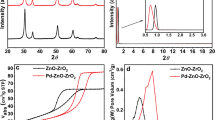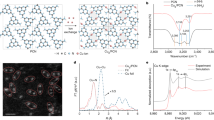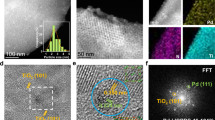Abstract
Palladium-catalysed cross-coupling reactions, central tools in fine-chemical synthesis, predominantly employ soluble metal complexes despite recognized challenges with product purification and catalyst reusability1,2,3. Attempts to tether these homogeneous catalysts on insoluble carriers have been thwarted by suboptimal stability, which leads to a progressively worsening performance due to metal leaching or clustering4. The alternative application of supported Pd nanoparticles has faced limitations because of insufficient activity under the mild conditions required to avoid thermal degradation of the substrates or products. Single-atom heterogeneous catalysts lie at the frontier5,6,7,8,9,10,11,12,13,14,15,16,17,18. Here, we show that the Pd atoms anchored on exfoliated graphitic carbon nitride (Pd-ECN) capture the advantages of both worlds, as they comprise a solid catalyst that matches the high chemoselectivity and broad functional group tolerance of state-of-the-art homogeneous catalysts for Suzuki couplings, and also demonstrate a robust stability in flow. The adaptive coordination environment within the macroheterocycles of ECN facilitates each catalytic step. The findings illustrate the exciting opportunities presented by nanostructuring single atoms in solid hosts for catalytic processes that remain difficult to heterogenize.
This is a preview of subscription content, access via your institution
Access options
Access Nature and 54 other Nature Portfolio journals
Get Nature+, our best-value online-access subscription
$29.99 / 30 days
cancel any time
Subscribe to this journal
Receive 12 print issues and online access
$259.00 per year
only $21.58 per issue
Buy this article
- Purchase on Springer Link
- Instant access to full article PDF
Prices may be subject to local taxes which are calculated during checkout





Similar content being viewed by others
References
Yin, L. & Liebscher, J. Carbon–carbon coupling reactions catalyzed by heterogeneous palladium catalysts. Chem. Rev. 107, 133–173 (2007).
Molnár, Á. Efficient, selective, and recyclable palladium catalysts in carbon–carbon coupling reactions. Chem. Rev. 111, 2251–2320 (2011).
Brown, D. G. & Boström, J. Analysis of past and present synthetic methodologies on medicinal chemistry: where have all the new reactions gone? J. Med. Chem. 59, 4443–4458 (2016).
Yang, H., Han, X., Li, G. & Wang, Y. N-heterocyclic carbene palladium complex supported on ionic liquid-modified SBA-16: an efficient and highly recyclable catalyst for the Suzuki and Heck reactions. Green. Chem. 11, 1184–1193 (2009).
Liu, J. Catalysis by supported single metal atoms. ACS Catal. 7, 34–59 (2017).
Zhang, H., Liu, G., Shi, L. & Ye, J. Single-atom catalysts: emerging multifunctional materials in heterogeneous catalysis. Adv. Energy Mater. 8, 1701343 (2018).
Zhu, C. et al. Single-atom electrocatalysts. Angew. Chem. Int. Ed. 56, 13944–13960 (2017).
Gates, B. C., Flytzani-Stephanopoulos, M., Dixon, D. A. & Katz, A. Atomically dispersed supported metal catalysts: perspectives and suggestions for future research. Catal. Sci. Technol. 7, 4259–4275 (2017).
Lucci, F. R. et al. Selective hydrogenation of 1,3-butadiene on platinum–copper alloys at the single-atom limit. Nat. Commun. 6, 8550 (2015).
Kyriakou, G. et al. Isolated metal atom geometries as a strategy for selective heterogeneous hydrogenations. Science 335, 1209–1212 (2012).
Qiao, B. et al. Single-atom catalysis of CO oxidation using Pt1/FeOx. Nat. Chem. 3, 634–641 (2011).
Zhang, H. et al. Catalytically highly active top gold atom on palladium nanocluster. Nat. Mater. 11, 49–52 (2012).
Yang, M. et al. A common single-site Pt(ii)–O(OH)x– species stabilized by sodium on 'active' and 'inert' supports catalyzes the water–gas shift reaction. J. Am. Chem. Soc. 137, 3470–3473 (2015).
Vilé, G. et al. A stable single-site palladium catalyst for hydrogenations. Angew. Chem. Int. Ed. 54, 11265–11269 (2015).
Kwak, J. H. et al. Coordinatively unsaturated Al3+ centers as binding sites for active catalyst phases of platinum on γ-Al2O3. Science 325, 1670–1673 (2009).
Chen, Z. et al. Stabilization of single metal atoms on graphitic carbon nitride. Adv. Funct. Mater. 27, 1605785 (2017).
Liu, P. et al. Photochemical route for synthesizing atomically dispersed palladium catalysts. Science 352, 797–800 (2016).
Grundner, S. et al. Single-site trinuclear copper oxygen clusters in mordenite for selective conversion of methane to methanol. Nat. Commun. 6, 7546 (2015).
Vorobyeva, E. et al. Tailoring the framework composition of carbon nitride to improve the catalytic efficiency of the stabilised palladium atoms. J. Mater. Chem. A 5, 16393–16403 (2017).
Feiz, A., Bazgir, A., Balu, A. M. & Luque, R. Continuous flow room temperature reductive aqueous homo-coupling of aryl halides using supported Pd catalysts. Sci. Rep. 6, 32719 (2016).
Zhang, X. et al. C-C coupling on single-atom-based heterogeneous catalyst. J. Am. Chem. Soc. 140, 954–962 (2018).
Thomas, A. A., Wang, H., Zahrt, A. F. & Denmark, S. E. Structural, kinetic, and computational characterization of the elusive arylpalladium(ii)boronate complexes in the Suzuki–Miyaura reaction. J. Am. Chem. Soc. 139, 3805–3821 (2017).
Thomas, A. A. & Denmark, S. E. Pre-transmetalation intermediates in the Suzuki–Miyaura reaction revealed: the missing link. Science 352, 329–332 (2016).
Sundermann, A., Uzan, O. & Martin, J. M. L. Computational study of a new Heck reaction mechanism catalyzed by palladium(ii/iv) species. Chem. Eur. J. 7, 1703–1711 (2001).
Xue, L. & Lin, Z. Theoretical aspects of palladium-catalysed carbon–carbon cross-coupling reactions. Chem. Soc. Rev. 39, 1692–1705 (2010).
García-Melchor, M. et al. Computational perspective on Pd-catalyzed C–C cross-coupling reaction mechanisms. Acc. Chem. Res. 46, 2626–2634 (2013).
Busch, M., Wodrich, M. D. & Corminboeuf, C. Linear scaling relationships and volcano plots in homogeneous catalysis—revisiting the Suzuki reaction. Chem. Sci. 6, 6754–6761 (2015).
Ortuño, M. A., Lledós, A., Maseras, F. & Ujaque, G. The transmetalation process in Suzuki–Miyaura reactions: calculations indicate lower barrier via boronate intermediate. ChemCatChem. 6, 3132–3138 (2014).
Ahlquist, M. S. G. & Norrby, P.-O. Dispersion and back-donation gives tetracoordinate [Pd(PPh3)4]. Angew. Chem. Int. Ed. 50, 11794–11797 (2011).
Kalz, K. F. et al. Future challenges in heterogeneous catalysis: understanding catalysts under dynamic reaction conditions. ChemCatChem. 9, 17–29 (2017).
Ravel, B. & Newville, M. Athena, Artemis, Hephaestus: data analysis for X-ray absorption spectroscopy using IFEFFIT. J. Synchrotron Radiat. 12, 537–541 (2005).
Kresse, G. & Furthmüller, J. Efficient iterative schemes for ab initio total-energy calculations using a plane-wave basis set. Phys. Rev. B 54, 11169–11186 (1996).
Kresse, G. & Furthmüller, J. Efficiency of ab-initio total energy calculations for metals and semiconductors using a plane-wave basis set. Comput. Mater. Sci. 6, 15–50 (1996).
Perdew, J. P. et al. Atoms, molecules, solids, and surfaces: applications of the generalized gradient approximation for exchange and correlation. Phys. Rev. B 46, 6671–6687 (1992).
Kresse, G. & Joubert, D. From ultrasoft pseudopotentials to the projector augmented-wave method. Phys. Rev. B 59, 1758–1775 (1999).
Grimme, S., Antony, J., Ehrlich, S. & Krieg, H. A consistent and accurate ab initio parametrization of density functional dispersion correction (DFT-D) for the 94 elements H–Pu. J. Chem. Phys. 132, 154104 (2010).
Henkelman, G., Uberuaga, B. P. & Jónsson, H. A climbing image nudged elastic band method for finding saddle points and minimum energy paths. J. Chem. Phys. 113, 9901–9904 (2000).
Álvarez-Moreno, M. et al. Managing the computational chemistry big data problem: the ioChem-BD platform. J. Chem. Inf. Model. 55, 95–103 (2015).
Acknowledgements
We thank ETH Zurich, the Swiss National Science Foundation (Grant no. 200021-169679) and MINECO (CTQ2015-68770-R) for financial support. E.F. thanks MINECO La Caixa-Severo Ochoa for a predoctoral grant through Severo Ochoa Excellence Accreditation 2014-2018 (SEV-2013-0319). M.A.O. acknowledges the Juan de la Cierva-Incorporación postdoctoral program (IJCI-2016-29762). S.M.C. acknowledges support from the Henslow Research Fellowship at Girton College, Cambridge. P.A.M. acknowledges the EPSRC (Grant no. EP/R008779/1) for funding. We thank ScopeM at ETH Zurich for access to its facilities, BSC-RES for providing generous computational resources, Diamond Light Source for access and support in the use of the electron Physical Science Imaging Centre (EM16967), R. Hauert for XPS measurements, D. N. Johnstone for assistance in acquiring data at ePSIC. G.V. and S.R. thank T. Weller (Idorsia Pharmaceuticals Ltd.) for his constant support.
Author information
Authors and Affiliations
Contributions
J. P.-R. conceived and coordinated all stages of this research. E.V. and Z.C. prepared and characterized the catalysts. G.V. and S.R. undertook the catalytic tests. E.F., M.A.O. and N.L. conducted the computational studies. S.M.C. and P.A.M. conducted the AC-STEM analysis. Z.C., E.V., S.M., G.V., E F., N.L. and J P.-R. co-wrote the manuscript in discussion with other co-authors.
Corresponding author
Ethics declarations
Competing interests
The authors declare no competing interests.
Additional information
Publisher’s note: Springer Nature remains neutral with regard to jurisdictional claims in published maps and institutional affiliations.
Supplementary information
Supplementary Information
Supplementary Figures 1–13, Supplementary Tables 1–7, Supplementary Methods and Supplementary References
Supplementary Video 1
Molecular dynamics simulation tracking the trajectory of a single Pd atom in a first principles run
Supplementary Video 2
Animation following the path for the Suzuki reaction with the Pd-ECN catalyst during the individual elementary steps calculated by DFT
Rights and permissions
About this article
Cite this article
Chen, Z., Vorobyeva, E., Mitchell, S. et al. A heterogeneous single-atom palladium catalyst surpassing homogeneous systems for Suzuki coupling. Nature Nanotech 13, 702–707 (2018). https://doi.org/10.1038/s41565-018-0167-2
Received:
Accepted:
Published:
Issue Date:
DOI: https://doi.org/10.1038/s41565-018-0167-2
This article is cited by
-
In situ biosynthesis of palladium nanoparticles on banana leaves extract-coated graphitic carbon nitride: An efficient and reusable heterogeneous catalyst for organic transformations and antimicrobial agent
Biomass Conversion and Biorefinery (2024)
-
Hydrogen-Mediated Photoelectrocatalysis with Nickel-Modified Poly(Heptazine Imides)
Electrocatalysis (2024)
-
Atomically dispersed materials: Ideal catalysts in atomic era
Nano Research (2024)
-
Hydrophobic Modification of Small-Pore Pd-SSZ-13 Zeolites for Catalytic Methane Combustion
Topics in Catalysis (2024)
-
Dynamic evolution of the active center driven by hemilabile coordination in Cu/CeO2 single-atom catalyst
Nature Communications (2023)



